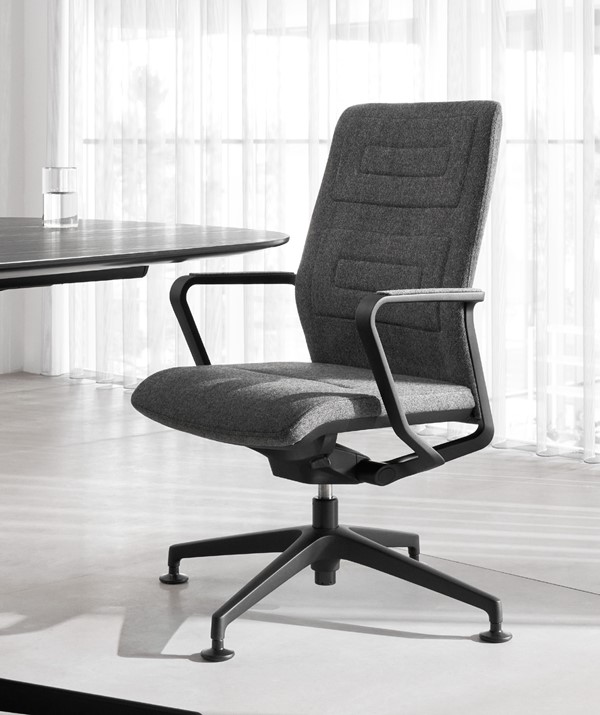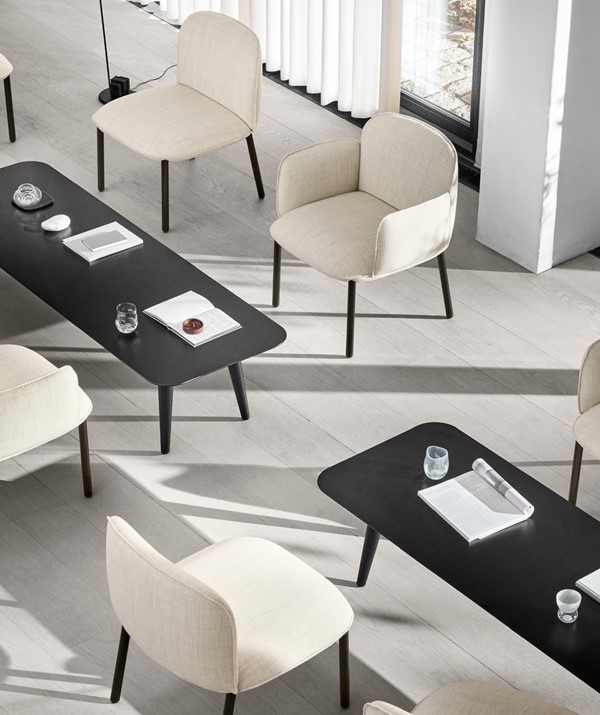As humans at work, we interact with physical furniture. This interaction is governed by our physical shape, physiology, psychology, society
and culture. Meeting our individual human needs is the key to successful furniture settings.
Furniture engages our senses. It’s one of the few things (other than our clothes) that we’re in physical contact with for large amounts of time.
This makes it different to other objects, we’re surrounded by furniture and it’s the relationship between shape, arrangement and space that
make it integral to our daily lives.
As well as playing a functional role, furniture affects our mood and behaviour. Specific furniture can reduce distraction or increase stimulation.
Posture
The body affects the mind and emotions, just as our minds and emotions affect the body. We change postures with our mood. When we feel elated, we stand up straight. When we feel deflated, we slouch, curving our backs.
01. Perching
We tend to lean on higher stools rather than sit on them. This tends to be a transitory action and is something we do for the short-term.
Perching is a position halfway between sitting and standing. When you perch you naturally engage your thigh, hip, core and back muscles. It requires some effort from your body to maintain the posture but moving away from a stool requires less energy than getting up from a low seat.
A key benefit of perching is that the open pelvic angle is better for spinal posture. A reduced risk of slouching encourages better breathing. The quicker, easier transition to standing can impact productivity and collaboration. There’s also better eye contact with others who are standing.
02. Standing
Breaking up periods of sitting with periods of standing and associated light activity can have important health benefits.
Standing burns more calories than sitting which can improve the way our body uses glucose and reduces the risks of cardiometabolic disorders. Standing encourages movement, in turn promoting more physical activity at work. When you stand, you find yourself shifting your weight. Those little movements make a huge difference to your energy levels. When we stand, we tend to adopt better body posture. When we sit, we are more passive than when we stand. If we sit and slouch in our seat, sliding half-way under our desks, we become incredibly passive.
Standing keeps us focused, not only because we’re more visible to others, but also because we’d normally “switch off” when sitting for long periods. On the other hand, when we stand, we become assertive and proactive. We have more confidence and tend to take greater control. Creativity takes energy and standing helps energise us, especially when we move about a room. You’ll notice that when people stand, they’re more engaged and participative. They’ll stand and write on a whiteboard when they want to demonstrate their creativity.


03. Formal Sitting
When we sit in the formal upright posture in a task chair, our bodies are in a position that helps us concentrate the most. When we adopt a good posture the vertebrae stack neatly on top of one another, so the spine is not straining to stay aligned.
Good posture means the body is relaxed, because the muscles are not straining to stay upright. Your body weight is split over your coxic and lower legs and your body is not having to have any input. The body
is supported and the mind is able to concentrate.
04. Relaxing
The relax posture opens up the body. It takes pressure off our diaphram
and allows our lungs to expand. We can breathe better and our arms fall away which makes us more physically open and likely to hear other
people’s perspectives.
Generally speaking, seats that are designed for the relaxed posture are used with low tables, which means you can see other colleagues’ whole body, including their gestures and postures as well as hearing their words. This posture generally leads to a more open discussion.
It is the informal nature of the posture that exposes the vulnerability of our human body that facilitates a different kind of workplace conversation.
05. Reclining
The posture we use more than any other, within a 24 hour period, is lying down. On average, we sleep in a reclined position for 8 hours a day.
When we’re reclined, our body weight isn’t just being transferred down through our spine and legs, but using our back as well. The head becomes much heavier and needs supporting. As our head and eyes are physically in a different position we have 'a different outlook' and see things in different ways. This position can be especially useful when we’re looking for creative solutions. A reclined posture encourages reflection and gives us the ability to look at problems differently.
Innovation is synonymous with creativity and problem-solving. By making physical changes to your environment, the idea is to take people into furniture settings that help them think differently and is a source of stimulation.
Adrian Campbell,
Workplace Design Consultant
Discover more
Are you in the right place?